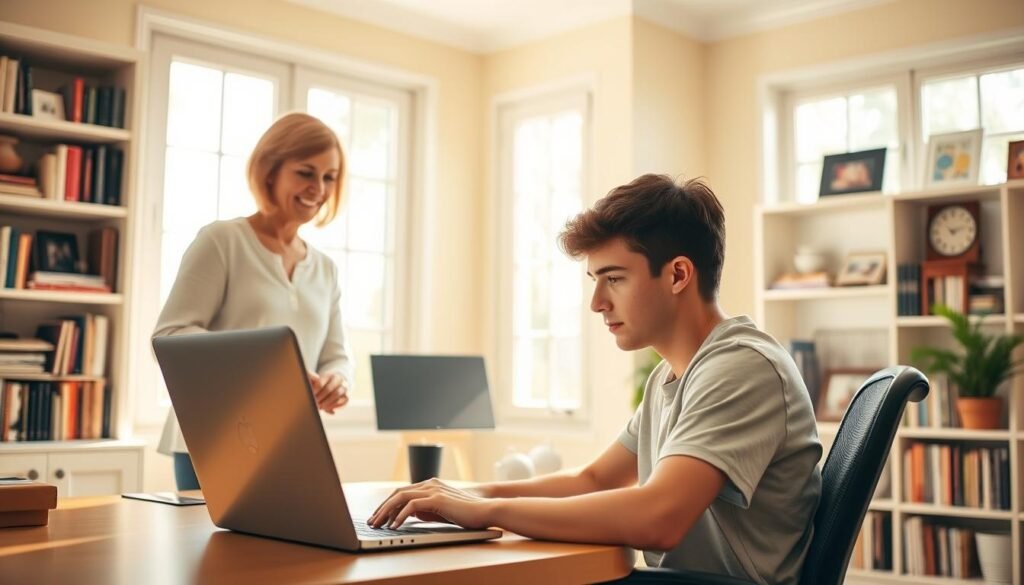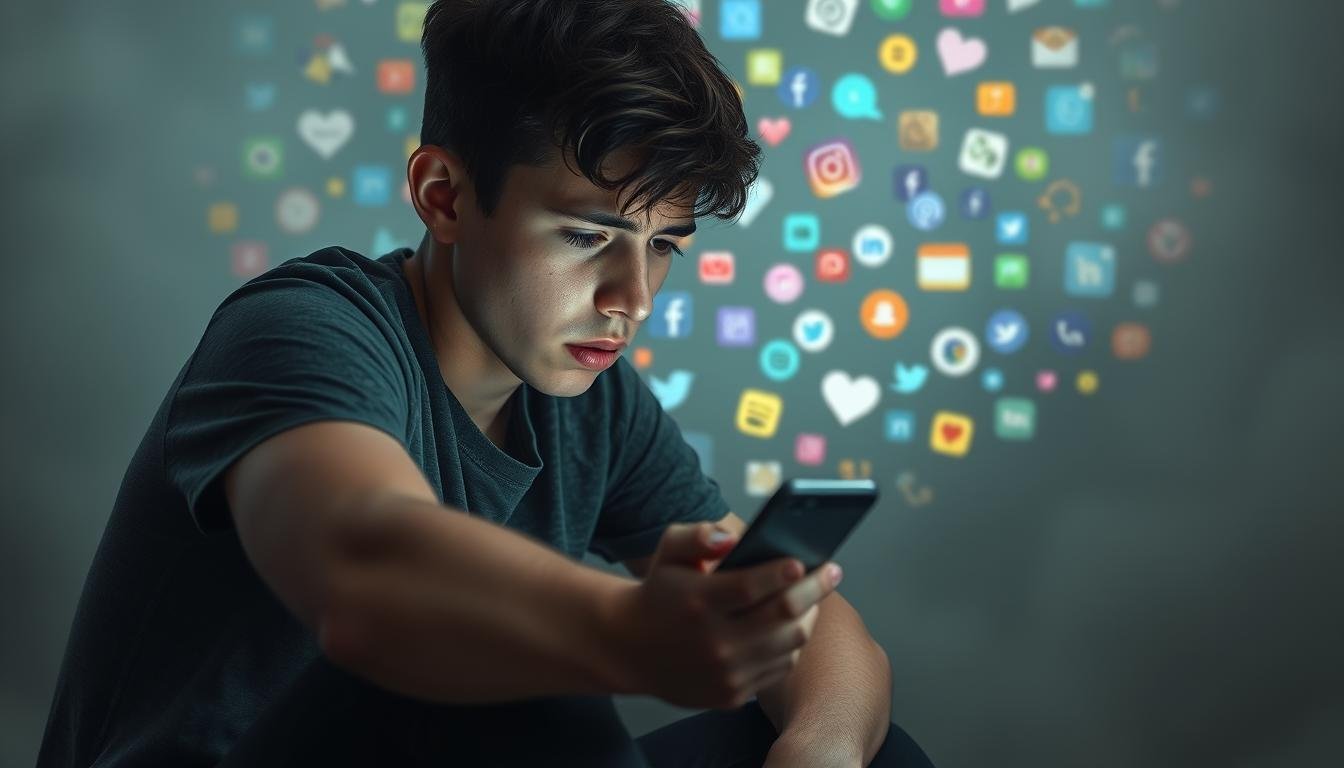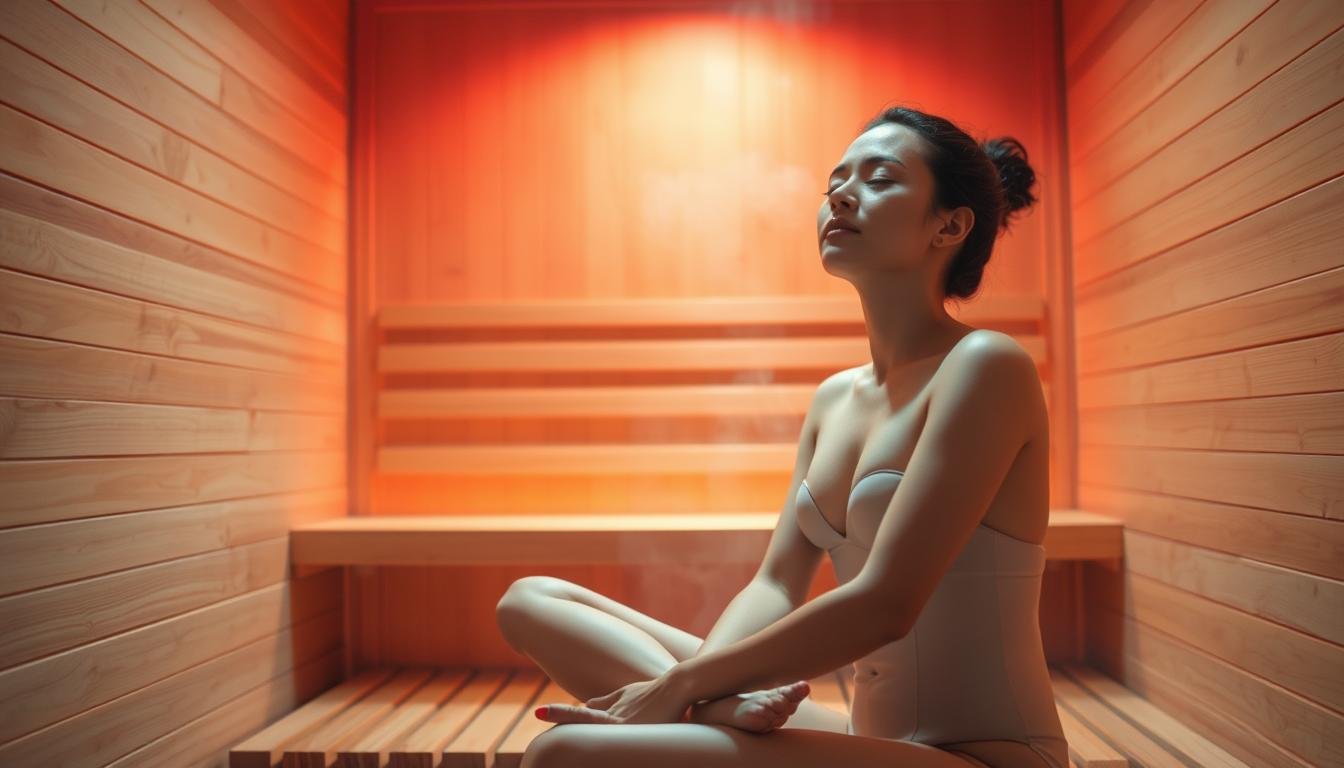Are we overlooking a crucial link between the digital world and the rising tide of teen anxiety?
The growing use of social media among teens has raised concerns. Parents, educators, and mental health experts are all paying attention. It’s key to grasp the complex issues at hand.
The link between screen time and its effects on youth is complex. It involves both risks and benefits. By looking closely at this balance, we can help young people stay mentally healthy in our digital world.
Key Takeaways
- Understanding the complex dynamics between social media and teen mental health.
- The potential risks associated with excessive screen time.
- Strategies for promoting healthy mental wellbeing in the digital age.
- The role of parents and educators in supporting youth mental health.
- The importance of balancing social media use with real-world interactions.
Understanding Social Media Mental Health Effects
It’s important to know how social media affects the mental health of teens today. The teenage years are key for mental health growth. Social media plays a big role in this.
To understand the mental health effects of social media, we need to know about teen mental health first. About 1 in 5 teens face mental health problems, like anxiety and depression. These issues can get worse because of social media.
Overview of Mental Health in Teens
Mental health problems in teens are getting more common. More teens are dealing with anxiety, depression, and other issues. School stress, social life, and other activities add to this problem.
| Mental Health Issue | Prevalence Among Teens | Potential Impact |
|---|---|---|
| Anxiety | 32% | Increased stress, decreased academic performance |
| Depression | 17% | Withdrawal from social activities, decreased motivation |
| Eating Disorders | 10% | Malnutrition, decreased self-esteem |
The Role of Social Media in Everyday Life
Social media is a big part of teens’ lives. It shapes how they see things, interact, and experience the world. More than 90% of teens aged 13-17 use social media. They spend hours each day on these platforms.
Seeing perfect and often fake content can hurt teens’ self-esteem and body image. It’s key to understand this to lessen social media’s bad effects on teen mental health.
The Link Between Social Media Use and Teen Anxiety
There’s a strong link between social media and teen anxiety. Teenagers face many challenges, and social media’s impact on their mental health is significant.
Today’s teens live in a world where social media is a big part of their lives. While it has many benefits, like connecting people and providing information, it also has negative effects on teen mental health.
Signs of Anxiety in Young People
Anxiety in teens can show up in many ways. It can be feelings of worry, fear, or unease that are too much and get in the way of their daily lives. Some common signs include:
- Restlessness and irritability
- Difficulty concentrating or making decisions
- Sleep disturbances, such as insomnia or nightmares
- Avoidance of social situations due to fear of judgment or rejection
It’s important to recognize these signs early. Parents, teachers, and mental health experts need to watch for them to help teens quickly.
How Social Media Can Amplify Anxiety
Social media can make anxiety worse for teens in several ways. For example, the perfect images and lifestyles shown online can make teens feel bad about themselves.
The constant need to show a perfect online image can lead to social media addiction. Teens feel they must always check and update their accounts.
Also, too much screen time can hurt teens’ sleep and focus. This can make anxiety worse. It’s key to understand how social media affects teens to find ways to help.
Screen Time: Balancing Benefits and Risks
Teenagers are spending more time on digital devices, affecting their mental health. Screen time can offer educational resources and social connections. But too much can harm their mental and physical health.
The American Academy of Pediatrics suggests teens should use screens for 1-2 hours daily. Yet, many teens spend much more time on screens for fun, socializing, and other activities.
Recommended Screen Time for Teens
Setting screen time limits is key for teens to balance their online and offline lives. The recommended screen time varies by age and situation. For example, the World Health Organization advises kids and teens to limit recreational screen time to 2 hours a day.
Negative Effects of Excessive Screen Time
Too much screen time can harm teens’ mental health, leading to anxiety and depression. It can also disrupt sleep, cause social isolation, and reduce physical activity. Excessive screen time can make teens more sedentary, leading to physical and mental health issues.
To lessen these risks, parents and caregivers should encourage teens to do offline activities. This could be sports, hobbies, or spending time with loved ones. By finding a balance, teens can lower their risk of mental health problems.
Social Comparison and its Impact on Self-Esteem
Social media is everywhere in teenagers’ lives, making social comparison a big worry for mental health experts. Social comparison is natural, but social media makes it worse. It shows us perfect, idealized lives all the time.
This can really hurt self-esteem, especially in teens. They are very sensitive to what others think. Seeing perfect lives online can make them feel not good enough.
The Role of Influencers and Ideal Images
Influencers and perfect images are big problems for teens. Social media influencers show only the best parts of their lives. This creates unrealistic expectations and makes us think others are better off.
“The more you compare yourself to others, the more you will feel inadequate and unhappy.” This shows how bad social comparison is for our minds. Teens who compare a lot on social media often feel worse about themselves and get more anxious.
Strategies to Combat Negative Comparisons
To fight negative comparisons, teens can try a few things. First, they can stop following accounts that make them feel bad. Second, they can do things offline that make them feel good about themselves, like sports or hanging out with friends.
- Practice self-compassion and focus on personal achievements.
- Limit social media use to specific times of the day.
- Engage in activities that promote self-esteem and confidence.
By using these strategies, teens can lessen the harm of social comparison. As Jean Twenge, a famous psychologist, says, “The goal is not to avoid social media, but to use it in a positive way.”
Being smart about social comparison can help teens use social media without hurting their mental health. It’s all about being aware and taking steps to stay healthy online.
Cyberbullying and Its Consequences
The digital age has brought many challenges for teenagers, with cyberbullying being a major concern. Cyberbullying is when people use digital platforms to intimidate or humiliate others. It can happen on social media, text messages, and online forums.
Defining Cyberbullying in the Digital Age
Cyberbullying is a big worry because it’s everywhere and always connected. Unlike old-school bullying, cyberbullying can follow victims home. The anonymity of the internet can make bullies bolder, leading to harsher harassment.
The effects of cyberbullying on teens can be really tough. It can make them feel isolated, depressed, and anxious. It’s important to see cyberbullying as a serious issue that can harm a teen’s mental health for a long time.
Support Resources for Affected Teens
There are many resources for teens dealing with cyberbullying. These include:
- Online support groups where teens can share their stories and find support.
- Counseling services that offer professional help and advice.
- Hotlines that provide quick support and guidance.
Parents, teachers, and friends should also know the signs of cyberbullying. They should know how to help. By working together, we can make the internet safer for teens.
| Resource Type | Description | Contact Information |
|---|---|---|
| Online Support Group | A place for teens to share their stories and get support. | Visit Website |
| Counseling Service | Professional counseling for teens facing cyberbullying. | 1-800-XYZ-1234 |
| Hotline | Quick support and advice for teens in crisis. | 1-800-ABC-5678 |
Social Media Detox: What It Means
Social media is everywhere, and detoxing from it is seen as a way to fight its bad effects on our minds. A social media detox means not using social media for a while. This can be from a few days to months.

Benefits of a Digital Break
One big benefit of a social media detox is it can make anxiety and depression symptoms better. It gives our minds a break from all the info online.
Also, detoxing can help you take back control of your online habits. This can make your life more balanced between being online and being offline. It’s good for your digital health.
Planning a Successful Detox
To do a social media detox right, start by setting goals. Think about what you want to get out of it. Maybe you want to spend less time on screens, feel better mentally, or just take a digital break.
- Figure out which social media sites you use the most and choose to avoid them.
- Decide how long you want to detox for, like a weekend or a week.
- Find other things to do instead of scrolling through social media, like reading, exercising, or hanging out with people.
By following these steps and knowing the good things about detoxing, you can manage your online life better. This can help improve your mental health.
Positive Uses of Social Media for Mental Wellbeing
Despite its downsides, social media is a great help for teens looking for mental health support. It offers a wealth of resources to improve mental wellbeing.
Online support groups are a big plus. They give teens a safe place to share and get support. These groups help teens feel less alone and understood.
Online Support Communities
Online groups are especially good for teens who feel isolated. They can share their struggles anonymously and get advice from peers. This openness helps teens talk more freely about their mental health.
Key benefits of online support communities include:
- Accessibility: Available 24/7, these communities can be accessed from anywhere, providing constant support.
- Anonymity: Teens can share their experiences without fear of judgment or repercussions.
- Peer Support: Connecting with others who have similar experiences can be incredibly validating.
Mental Health Resources Shared on Social Media
Social media also shares mental health resources. This includes articles, videos, and infographics on managing anxiety and depression. Mental health organizations and influencers spread this valuable content to educate teens.
Some notable examples of mental health resources shared on social media include:
- Coping strategies for managing anxiety and stress.
- Guidance on recognizing the signs of mental health issues.
- Information on professional help and therapy options.
By using social media wisely, teens can find support and resources for their mental wellbeing. As social media grows, it’s important to see its positive side in mental health discussions.
Empowering Parents to Manage Screen Time
Managing screen time for teenagers can be tough, but it’s doable with the right approach. It’s important to understand how screen time affects teens and take steps to reduce any harm.
Setting Healthy Boundaries for Teens
Setting limits on screen time is key. Parents should create rules that fit their teen’s age and maturity. This might mean no screens during meals, before bed, or during family time.
To enforce these rules, parents can use software to track and limit screen time. It’s also crucial to talk to teens about why these rules are important. Discuss how too much screen time can lead to social media addiction and harm teenage mental health concerns.
| Boundary Setting Strategies | Description | Benefits |
|---|---|---|
| Screen-Free Zones | Make certain areas or times screen-free, like the dinner table or bedrooms. | Boosts family bonding and improves sleep. |
| Time Limits | Set daily limits on screen time. | Reduces the risk of too much screen time and encourages other activities. |
| Monitoring Software | Use software to track and control screen time. | Gives insights into screen time habits and helps stick to limits. |
Communicating Openly about Social Media Use
Talking openly about social media is crucial for teens. Parents should have regular, non-judgmental chats with their teens about their online activities. This helps understand the screen time effects on their mental health.
Creating a safe space for teens to share their online experiences helps parents guide them. This way, parents can ensure their teens use social media responsibly and safely.

The Future of Social Media and Teen Mental Health
The future of social media is closely tied to the mental health of teens. It brings both challenges and chances for improvement. We must keep up with new trends and solutions to help teens stay well in the digital world.
Emerging Trends in Social Media Use
New trends will shape social media’s impact on teen mental health. These include augmented reality (AR) experiences, more focus on online safety and privacy, and the rise of social commerce. It’s key to think about how these trends might affect teens.
AR experiences could change how teens interact online. Online safety and privacy are crucial to protect them from harm. Social commerce might also affect their self-esteem and body image.
| Trend | Potential Impact | Mitigation Strategy |
|---|---|---|
| Augmented Reality (AR) Experiences | Immersive experiences may alter online interactions | Implement age restrictions and parental guidance |
| Increased Focus on Online Safety and Privacy | Better protection from cyberbullying and data misuse | Regularly update privacy policies and safety features |
| Social Commerce | Influences self-esteem and consumer behavior | Promote responsible advertising practices |
Potential Solutions for Promoting Well-Being
To help teens stay well online, we can try a few things. We can offer education and awareness programs to teach teens about healthy social media use. We can also make platform design changes that focus on well-being. Lastly, we can work together with different groups to tackle these big issues.
Education programs can help teens make smart choices about social media. Design changes, like features that help them take breaks, can also support better habits. Working together with tech companies, mental health experts, and policymakers is key to solving these problems.
By understanding new trends and trying out solutions, we can make the online world safer for teens. As social media keeps changing, we need to keep researching and working together to help teens stay well online.
Actionable Tips for Teens to Support Mental Health
Teenagers can take steps to fight the bad effects of screen time and social media on their minds. By adding simple habits to their day, they can handle teen anxiety better. This helps them stay well overall.
Mindfulness and Self-Care Practices
Mindfulness, like meditation and deep breathing, can calm teens’ minds and lower stress. Doing self-care, like yoga, journaling, or being in nature, also boosts mental health.
Engaging in Offline Activities for Balance
Doing things offline, like sports, hobbies, or creative projects, helps teens balance their lives. It lessens the bad effects of social media on their minds. This leads to a more rewarding life.
By using these tips, teens can take charge of their mental health. They can make their online time better and more positive.



